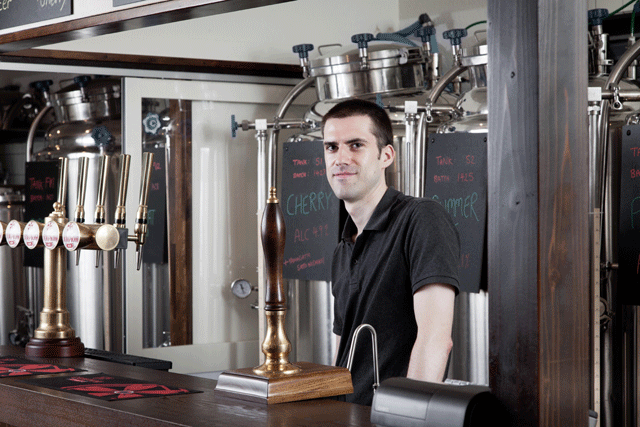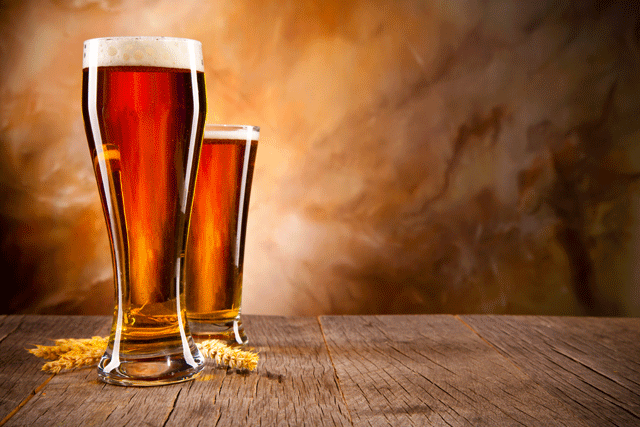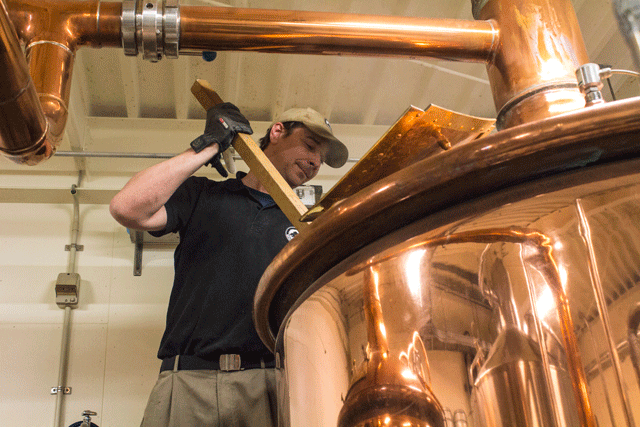Craft beer is slowly but surely educating the palates of Japan’s beer drinkers and bringing with it some equally unique stories from the start-ups producing it.
By Chris Zajko
Japan’s craft beer industry has been going from strength to strength for many years now.
Stemming from the scene’s much-celebrated early incarnation in the 1990s, there has been a series of triumphs resulting in many of Japan’s more interesting and flavorsome brews holding their own on the international stage. The beer-drinking public are rapidly becoming more interested in, and educated about, the nuances of craft beer’s seemingly endless flavors and varieties.
It’s safe to say the scene has taken cues and influence from abroad, helped along by a handful of expats setting up shop in Japan. They bring with them extensive knowledge and experience from exposure to more established international markets and a DIY attitude often born from the home-brewing cultures of the UK and North America.
The growth of the industry, however, has not been without its share of difficulties and hurdles.
In Japan, home-brewing beer is illegal, due to an outdated law prohibiting the practice—a relic left over from the Meiji Era (1867–1912). This has restricted local people from gaining the experience and exposure to small-batch, craft-style beer, which has in turn slowed the progress of the industry by lessening the opportunity for people to hone their skills and practice their craft without high financial risks.
Another major difficulty faced by smaller brewers in Japan is the high cost of ingredients—malt, hops and yeast—as they are most often imported from overseas. Combined with the exorbitant ¥222 per liter tax rate—much higher than it is for other alcohol types—that the government charges, inflated retail prices are the upshot. For small, start-up operations facing these financial hurdles, there is no choice but to pass the costs onto the consumer. There is no wonder craft beer prices can be as much as twice that of your traditional Japanese lagers produced by one of the “big four” in the business (Suntory, Sapporo, Kirin and Asahi) who collectively account for more than 95% of all beer sold in Japan.
In fact, the dominance of these major players has made it difficult for Japanese beer drinkers to embrace microbrews, despite the country’s long tradition of artisan production. As James Williams, an Englishman who owns the British-style pub and brewery Campion Ale, explains, “Within Japan there’s a real interest in hand-made, unique products. For nihonshu, or Japanese sake, the idea of having a very small-scale unique sake brewery is quite common. There’s a precedent [for beer], but there’s not the experience. A lot of people don’t realize that beer can also be a small-scale craft-type experience. They have the image of the very big factory and the big distributors and the big makers.”
“Japan is now experiencing an awakening, [an] enlightenment…about what craft beer is.”
Interestingly, despite craft beer’s relatively small “slice of the pie” (microbreweries account for only about 1% of total beer consumption) and the difficulties faced by its producers, the segment has actually been growing steadily for a number of years. According to The Craft Beer Association in Japan, 2008’s domestic production of craft beer sat at around 29 million liters, and reached approximately 35 million liters only 5 years later. The Association’s Chief Operating Officer Yusuke Yamamoto is optimistic about further growth and says that craft beer shipments from domestic breweries have grown at least an additional 10% since 2013.
The rest of the world is taking notice too, with a string of international awards: Osaka’s Minoh Brewery was named best Imperial IPA (India Pale Ale) at last year’s World Beer Awards and Kawagoe’s Coedo Brewery scored a silver in the same year at the World Beer Cup’s “American-style amber lager” category for their golden brown Kyara beer.
It’s not smooth sailing for the rest of the beer industry though. The overall consumption of beer has been declining in Japan for decades, from around 7.3 billion liters in 1999 to just under 6.2 billion liters in 2014, according to Euromonitor International.
So why, in a declining industry, are smaller, more experimental operators enjoying repeated successes, not only in their increased production and consumption, but also through critical acclaim from international connoisseurs and local punters alike?
The answer is more than likely beer education. The general public is becoming more aware of the diversity and excitement of craft beer through an increase in beer festivals, brewpubs and craft beer bars.
Yokohama-based beer consultant and writer Lee Reeve thinks we’re now at a stage of growth in which “Japan is now experiencing an awakening, [an] enlightenment” as “the general public becomes increasingly educated about what craft beer is.” This may be a little dramatic, but there are some signs that something akin to a large-scale rebellion is taking place against the blandness of local beer produced by the big four that have monopolized the market for so long.
Unsurprisingly, the likes of Kirin are beginning to change tack by adding their own line of craft beer-esque products to their repertoire in an attempt to cash in on the trend. Brimmer Brewing’s American director and brewmaster Scott Brimmer doesn’t feel threatened by these new additions. Instead, he sees them as a stepping stone for consumers. “A lot of the general public that go to convenience stores to buy beer are seeing new beers out there. If they try some of those beers, maybe they’ll venture a little further and try some of the smaller breweries, like us.”
Yamamoto estimates there are around 225 craft breweries in Japan today, due to the brewing’s surge in popularity over a the last few years. Of this number, there a handful of brewers that have been chipping away at the market since the 90s. Brewers like Echigo, Hitachino Nest and Coedo were amongst the first craft brewers in Japan (all forming within a couple of years of 1993’s liquor tax reforms) and have paved the way for the likes of DevilCraft, Campion Ale, and Brimmer Brewing to flourish in the Japanese market more recently.
Another important ingredient in Japan’s continued craft beer growth is the rise of brewpubs—venues that serve their own small batch products, usually brewed on site by hand. In Tokyo alone, the number of brewpubs has increased from less than 10 to around 80 in only the last few years.
A common inspiration running through some of the expat-owned craft beer businesses is that their owners didn’t necessarily come to Japan with the goal of cashing in on the trend or filling a gap in the market, but rather a more natural progression that led them to their destiny.
Brimmer says, “Out of any of the foreigners I don’t know anyone that specifically came here to make beer for Japan.” Although a highly experienced and university educated brewer himself, he notes that “A lot of foreigners weren’t necessarily professional brewers before….A lot of these people have been home-brewing as a hobby for many years…. They’re confident enough to where they think they can make a business out of it.”
Jason Koehler, a founding partner of DevilCraft, may be the exception to that rule. As he explains, “I came to Japan knowing I wanted to brew beer here before I had even relocated.” Koehler studied brewing at Chicago’s Siebel Institute and landed his first job in Japan as an assistant brewer, before going out on his own with the help of two partners. He attributes the rise of more foreign-owned businesses to “a hunger for the beers of their homeland.”
“Microbreweries were a big thing in the 1990s in the US, and the UK never really lost their pub and real ale culture. For those who were already brewers, the transition to brewing in Japan was natural. For others, it was about filling a need for what they love.”
Just as the cornerstones of craft beer in Japan these days are individuality and uniqueness, so too are the stories and paths traveled of the international brewers and brewpub owners that now call Japan home. While there is no discernible pattern regarding the motivation for coming to Japan, they, along with a variety of Japanese-owned craft beer businesses, are all contributing to the more flavorsome end of the beer spectrum that is taking hold of a healthy corner of the market. Brimmer reinforces the cautious optimism felt throughout the industry, estimating that Japan is “probably about where the States were about ten to fifteen years ago…but it’s gaining pretty fast. In a year or two, it might just be a couple of years behind.”
It seems that the maturing of many Japanese beer drinkers’ palates, combined with the country’s love affair with craftsmanship and deep culture of perfectionism, has the industry set for continued growth and international acclaim over the coming years.

James Williams, director of Campion Ale, manning the bar at the British-style pub and brewery in Asakusa.
For more information please visit:
Campion Ale: www.campionale.com
DevilCraft: en.devilcraft.jp
Baird Beer: bairdbeer.com
Brimmer Brewing: www.brimmerbrewing.com
Images: Brimmer Brewing and Campion Ale
– Chris Zajko
Updated On April 26, 2021










